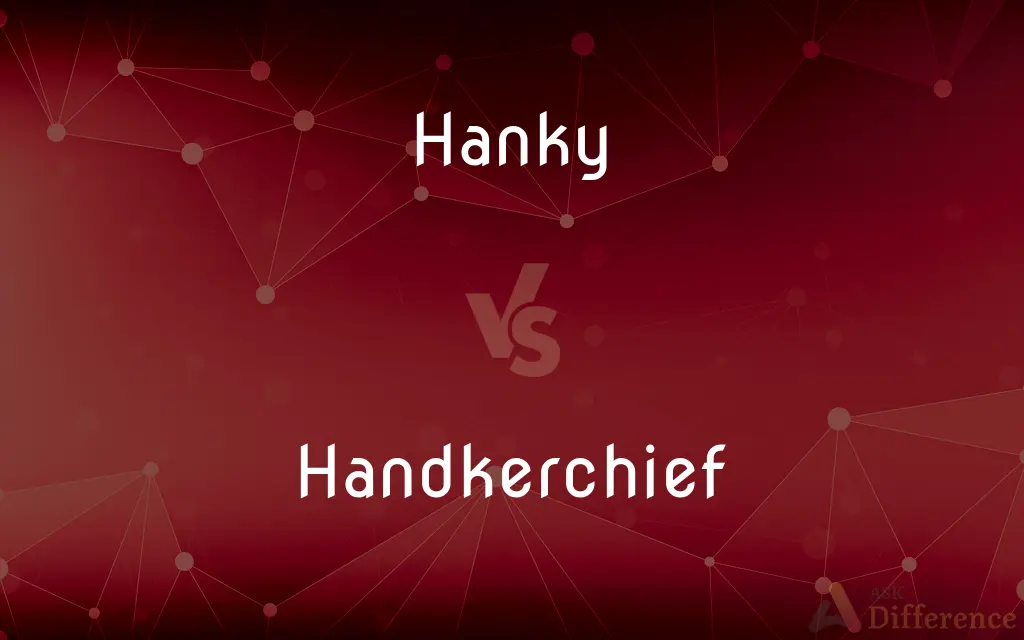Hanky vs. Handkerchief — What's the Difference?
By Tayyaba Rehman & Urooj Arif — Updated on March 30, 2024
A hanky is a casual term for a handkerchief, a piece of fabric used for personal hygiene or as an accessory. Both serve similar purposes, but "hanky" conveys a more informal tone.

Difference Between Hanky and Handkerchief
Table of Contents
ADVERTISEMENT
Key Differences
A handkerchief is a square piece of fabric, traditionally used for personal hygiene purposes such as blowing the nose, wiping sweat, or even as a fashion accessory in a suit's pocket. It's often made from cotton, silk, or linen and can feature decorative patterns or embroidery. The term "handkerchief" suggests a more formal or traditional usage. In contrast, "hanky" is a colloquial term that refers to the same item but conveys a more informal or affectionate tone. While the functionality remains the same, the choice of term can reflect the user's approach or attitude towards the item.
Both handkerchief and hanky are used for practical purposes, like personal hygiene, but they also serve as fashion statements or etiquette accessories in certain social settings. A handkerchief might be chosen for formal occasions, such as weddings or business meetings, where it adds a touch of class or sophistication to a person's attire. On the other hand, a hanky might be the preferred term in everyday conversation, reflecting a more casual or utilitarian use of the item.
The choice between using a handkerchief or hanky can also reflect cultural nuances or personal preferences. In some cultures, carrying a handkerchief is seen as a sign of preparedness and good manners. Meanwhile, referring to it as a hanky may suggest a more laid-back or practical approach to its use. Regardless of the term used, both serve the purpose of offering a reusable, eco-friendly alternative to disposable tissues.
In terms of maintenance and care, both handkerchiefs and hankies require regular washing to ensure hygiene. The care taken in choosing, using, and maintaining a handkerchief or hanky can also reflect personal values, such as an appreciation for sustainability or a preference for traditional over disposable products.
Despite the differences in terminology, the choice between handkerchief and hanky often comes down to personal preference and context. Whether chosen for practical reasons, as a fashion accessory, or as a nod to etiquette, both terms refer to a versatile and enduring personal item.
ADVERTISEMENT
Comparison Chart
Definition
A square piece of fabric used for personal hygiene or as an accessory.
Informal term for a handkerchief.
Tone
Formal, traditional.
Informal, casual.
Usage
Often used in formal settings or as a fashion accessory.
Used casually in everyday conversation.
Material
Cotton, silk, linen, with possible decorative patterns.
Same materials, but the term doesn’t imply a particular style.
Cultural connotation
Associated with preparedness and good manners.
Suggests a laid-back or practical approach.
Compare with Definitions
Hanky
A piece of fabric used for personal hygiene, like blowing the nose, or as a fashion accessory.
He carried a silk handkerchief in his suit pocket to the wedding.
Handkerchief
Casual term for a small cloth used for personal nose-wiping or hygiene.
She pulled out a hanky to wipe away her tears.
Hanky
A reusable alternative to disposable tissues, reflecting eco-friendly values.
Instead of using tissues, he preferred a washable handkerchief for daily use.
Handkerchief
Made from the same materials as a handkerchief, without the formal implication.
Her favorite cotton hanky was soft and absorbent.
Hanky
Typically made from cotton, silk, or linen, often with decorative patterns.
Her linen handkerchief was embroidered with her initials.
Handkerchief
Often used in a more utilitarian or casual context.
I keep a hanky on hand when I'm out for a run.
Hanky
Used in formal settings or as part of traditional etiquette.
At the meeting, he discreetly used his handkerchief.
Handkerchief
Emphasizes practicality and sustainability in daily life.
Using a hanky is her small way of reducing waste.
Hanky
Can be a stylish addition to formal wear.
The handkerchief in his breast pocket matched his tie.
Handkerchief
Reflects a more casual or affectionate approach to its use.
He always carries a hanky in his backpack for emergencies.
Hanky
A handkerchief.
Handkerchief
A handkerchief (; also called a hankie or, historically, a handkercher) is a form of a kerchief or bandanna, typically a hemmed square of thin fabric which can be carried in the pocket or handbag, and which is intended for personal hygiene purposes such as wiping one's hands or face, or blowing one's nose. A handkerchief is also sometimes used as a purely decorative accessory in a suit pocket; it is then called a pocket square.
Hanky
(colloquial) handkerchief
Handkerchief
A square of cotton or other finely woven material intended for wiping one's nose.
Hanky
Same as handkerchief.
Handkerchief
A small square of cloth used especially for wiping the nose or mouth.
Hanky
A square piece of cloth used for wiping the eyes or nose or as a costume accessory
Handkerchief
A large piece of cloth worn as a decorative article; a scarf.
Handkerchief
A piece of cloth, usually square and often fine and elegant, carried for wiping the face, eyes, nose or hands.
Handkerchief
A piece of cloth shaped like a handkerchief to be worn about the neck; a neckerchief or neckcloth.
Handkerchief
A piece of cloth, usually square and often fine and elegant, carried for wiping the face or hands.
Handkerchief
A piece of cloth shaped like a handkerchief to be worn about the neck; a neckerchief; a neckcloth.
Handkerchief
A square piece of cloth used for wiping the eyes or nose or as a costume accessory
Common Curiosities
Is there a difference in material between a hanky and a handkerchief?
No, both are made from similar materials such as cotton, silk, or linen; the difference lies in the formality and usage context rather than the material.
What is a handkerchief?
A handkerchief is a square piece of fabric used for personal hygiene or as a fashion accessory, often made of cotton, silk, or linen.
Can a hanky be a fashion statement?
While typically more casual, a hanky can also be used fashionably depending on its design and how it is carried or displayed.
How should a handkerchief be cared for?
Handkerchiefs should be regularly washed and properly dried to maintain hygiene and longevity.
Are there etiquette rules for using a handkerchief?
Traditional etiquette suggests discreet use of handkerchiefs, especially in formal settings, and regular washing.
What does hanky mean?
Hanky is a colloquial term for a handkerchief, suggesting a more informal or casual use of the item.
Are handkerchiefs still used today?
Yes, handkerchiefs are still used for hygiene, as fashion accessories, and for practical purposes, appreciated for their sustainability.
Why might someone prefer a handkerchief over disposable tissues?
For reasons of sustainability, elegance, and cost-effectiveness over time, as handkerchiefs can be reused.
Can a handkerchief serve as a keepsake or gift?
Yes, especially if it is embroidered or has sentimental value, making it a thoughtful gift or keepsake.
How has the perception of handkerchiefs and hankies changed over time?
While their practical use has remained consistent, the cultural and fashion significance of handkerchiefs and hankies has evolved, reflecting broader changes in society and attitudes towards sustainability.
Is it acceptable to use a hanky in professional settings?
Yes, as long as it is used discreetly and kept clean, it is acceptable in most professional settings.
How can a hanky contribute to a more sustainable lifestyle?
By reducing reliance on disposable tissues, a hanky offers an eco-friendly alternative that minimizes waste.
Share Your Discovery

Previous Comparison
Flip vs. Flick
Next Comparison
Automative vs. AutomotiveAuthor Spotlight
Written by
Tayyaba RehmanTayyaba Rehman is a distinguished writer, currently serving as a primary contributor to askdifference.com. As a researcher in semantics and etymology, Tayyaba's passion for the complexity of languages and their distinctions has found a perfect home on the platform. Tayyaba delves into the intricacies of language, distinguishing between commonly confused words and phrases, thereby providing clarity for readers worldwide.
Co-written by
Urooj ArifUrooj is a skilled content writer at Ask Difference, known for her exceptional ability to simplify complex topics into engaging and informative content. With a passion for research and a flair for clear, concise writing, she consistently delivers articles that resonate with our diverse audience.















































